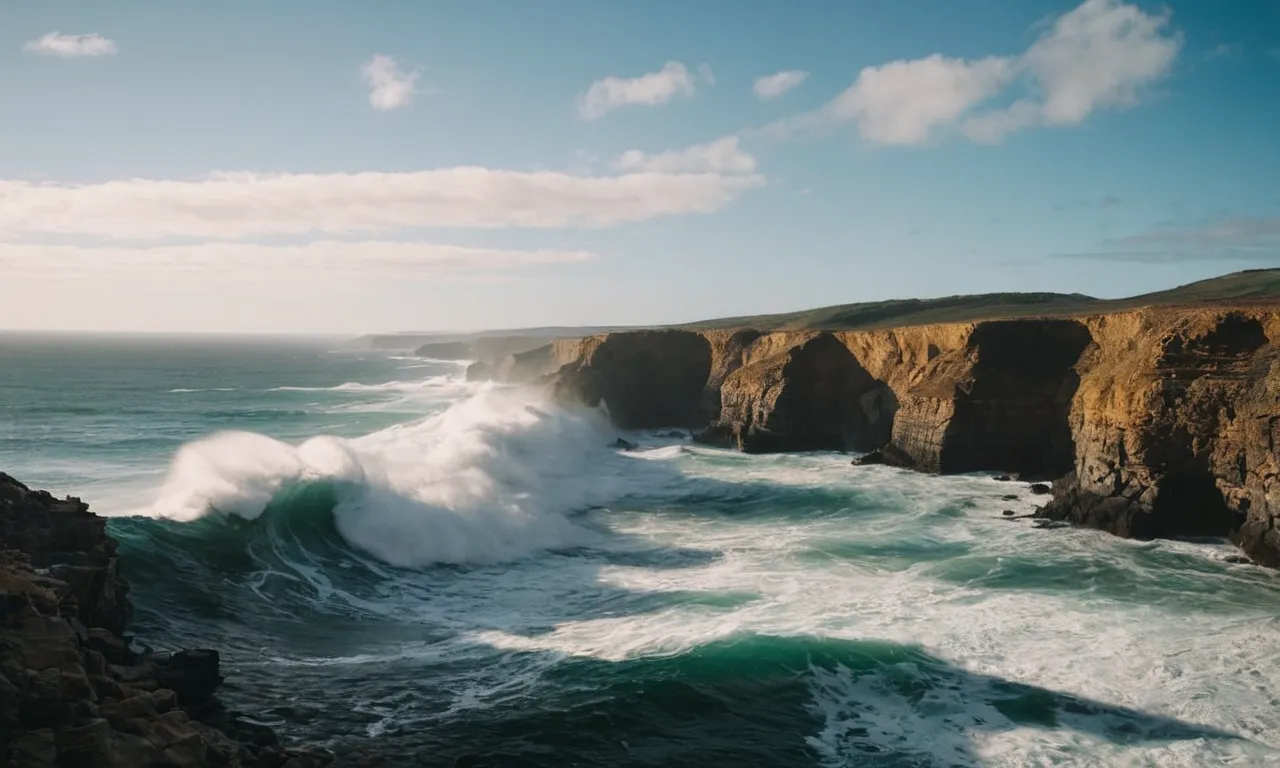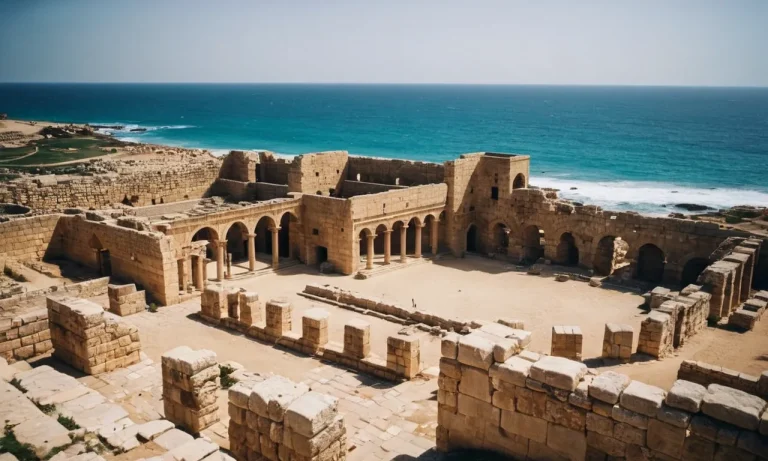What Does The Bible Say About The Ocean?
The vast, blue ocean has captivated humanity since the beginning of time. Its mysteries and wonders inspire awe and curiosity to explore the depths. If you’re wondering what the Bible reveals about the ocean and its significance, this comprehensive guide has the answers.
If you’re short on time, here’s a quick answer to your question: The Bible depicts the ocean as a symbol of God’s power, greatness, and mystery. Key passages describe God setting boundaries for the seas, comparing His wisdom to the ocean’s depths, and Jesus demonstrating His authority by calming storms.
The Ocean in Creation
God Created the Seas
The Bible clearly states that God created the seas on the third day of creation (Genesis 1:9-10). As the ultimate Creator, God spoke the oceans into existence, demonstrating His awesome power over the natural world. The seas cover about 70% of the planet, encompassing 139.7 million square miles.
Their vastness speaks to God’s capacity to create expansive realms for life to flourish.
God Set Boundaries for the Ocean
In addition to creating the oceans, God also set limits on them. Genesis 1:9 notes that the waters were gathered in one place, allowing dry land to emerge. God intentionally confined the oceans within certain parameters, establishing coastlines and boundaries they cannot surpass (Psalm 104:9; Jeremiah 5:22).
Even amidst powerful storms, the seas obey God’s appointed borders.
This demonstrates God’s sovereignty and reminds us that the forces of nature ultimately answer to Him. Though the oceans may seem uncontrollable to us, God effortlessly keeps them in check using barriers invisible to the human eye.
The Seas Declare God’s Glory
The oceans don’t just display God’s creative and sovereign power – they also proclaim His glory and attributes (Psalm 29:3). Their sheer enormity reflects His infinite greatness. Their unfathomable depth speaks of divine mystery beyond human understanding.
The diversity of sea creatures exhibit His endless capacity for invention and attention to detail (Psalm 104:25).
In fact, scientists estimate over 230,000 marine species exist, each exhibiting the Master Designer’s artistry. Coral reefs like Australia’s Great Barrier Reef spanning over 1,400 miles visibly sing God’s praises through their vibrant beauty and diversity of life.
Ultimately, the oceans in all their splendor give us glimpses of God’s eternal power and divinity, leaving mankind without excuse in denying His reality (Romans 1:20). Their astounding attributes direct our attention toward their glorious Creator.
Imagery and Symbolism of the Ocean
Depictions of the Ocean’s Depth and Vastness
The Bible often portrays the ocean as immeasurably deep and vast to represent the similarly unfathomable nature of God (Job 38:16; Psalm 36:6). Just as no one can fully explore the ocean’s depths, no one can fully comprehend everything about God.
The ocean’s seeming endlessness reminds us of God’s infinite nature.
Passages like Psalm 107:23-24 describe sailors being awestruck by the ocean’s enormity: “Some went down to the sea in ships, doing business on the mighty waters; they saw the deeds of the Lord, his wondrous works in the deep.”
This immense, awe-inspiring ocean points to the wonders and glory of God’s creation.
The Roaring Waves Represent Chaos or Trouble
The tumultuous, churning waves of the ocean often symbolize trouble, chaos, or distress in the Bible. Psalm 42:7 says, “Deep calls to deep in the roar of your waterfalls; all your waves and breakers have swept over me.”
Here, the psalmist feels overwhelmed by trials, represented by powerful, crashing waves.
Isaiah 57:20 makes a similar comparison: “But the wicked are like the tossing sea, which cannot rest, whose waves cast up mire and mud.” Just as the restless ocean stirs up sediment from the seafloor, the wicked continually stir up trouble and strife, preventing peace.
Jesus Calms the Storm
One of the most famous ocean-related stories is when Jesus calms the storm on the Sea of Galilee (Mark 4:35-41). The disciples are terrified by furious winds and waves battering their boat, representing the storms and chaos that often come in life.
But Jesus speaks and the sea becomes completely calm, displaying his authority over nature and trials.
This reminds us that though we face many troubles in this world, Jesus has power over any struggle we endure and can calm our personal storms if we call on him. As Psalm 93:3-4 declares, “The seas have lifted up, O Lord…mightier than the thunders of many waters, mightier than the waves of the sea, the Lord on high is mighty!”
References to Sea Creatures and Sailing
Stories Featuring Fish and Marine Wildlife
The Bible contains several stories involving fish and other sea creatures. One famous example is the story of Jonah and the whale. Jonah was commanded by God to go to the city of Nineveh, but instead he sailed in the opposite direction.
His ship was caught in a terrible storm, and the sailors threw Jonah overboard, where he was swallowed by a giant fish (Jonah 1:17). Jonah spent three days and nights inside the fish before being vomited up onto dry land (Jonah 2:10). This story illustrates God’s control over creation.
Another key story is when Jesus multiplied five loaves of bread and two fish to feed over 5,000 people (Matthew 14:13-21). This miracle demonstrates Jesus’ divine power and compassion for the crowds who gathered to hear his teaching.
In John 21, after his resurrection, Jesus meets his disciples by the Sea of Galilee and performs another fish-related miracle – filling their nets with 153 large fish after a night of catching nothing.
The Book of Job also references a variety of sea creatures, including the leviathan – a monstrous sea creature with powerful jaws (Job 41:1-34). This passage illustrates God’s sovereignty over all creation, both land and sea.
Passages About Ships and Seafaring
The Bible contains various passages referencing ships and seafaring. For example, much of the story of Paul’s missionary journeys was spent aboard ships sailing around the Mediterranean Sea (Acts 27-28). This includes the story of Paul’s shipwreck while being taken prisoner to Rome.
King Solomon’s ships are also mentioned frequently (1 Kings 9:26-28; 10:11,22). Solomon built a navy of ships to sail to foreign lands and bring back exotic cargo like gold, silver, ivory, apes, and peacocks. The ships would depart every three years on long voyages and return carrying riches.
Noah’s ark is another key seafaring vessel in the Bible (Genesis 6-9). God commands Noah to build a massive ship to preserve representatives of all living creatures through the Flood. The ark tosses about in the floodwaters for many days before coming to rest on the mountains of Ararat when the waters recede.
In the Gospels, Jesus and his disciples are recorded sailing around the Sea of Galilee. On one occasion, Jesus calms a storm that was tossing their boat about and frightening the disciples (Mark 4:35-41). This awe-inspiring event again points to Christ’s divine identity and mastery over the creation.
Beyond specific stories, the Bible also uses general maritime imagery and metaphors to illustrate broader spiritual truths. Examples include comparing the guidance of God to an anchor (Hebrews 6:19), righteous people to sturdy ships (Proverbs 31:14), and the overwhelming flood of trials to massive waves (Psalm 42:7).
As an agrarian and seafaring civilization, biblical imagery often reflected these elements of daily life.
Conclusion
As we have seen, the Bible uses the ocean and phenomena associated with it in profound ways. More than just a geographical feature, the seas in Scripture symbolize the mysteries and power of God. Jesus Christ’s authority extends even over winds and waves.
By exploring what the Word says about the waters, we gain deeper awe for our Creator who set everything in motion.








